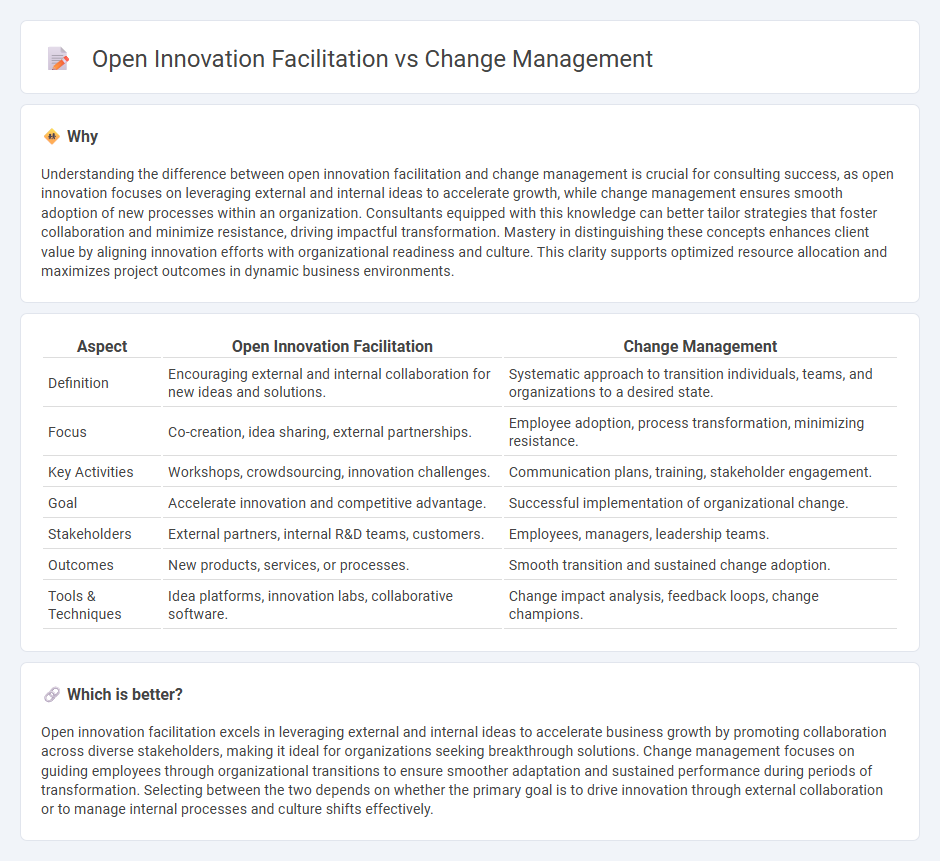
Open innovation facilitation accelerates collaborative idea exchange between organizations and external partners to drive breakthrough solutions, while change management focuses on guiding internal transitions and employee adaptation to new processes or technologies. Leveraging open innovation expands access to diverse expertise and novel resources, contrasting with change management's emphasis on minimizing resistance and ensuring smooth implementation within the organizational structure. Discover how integrating open innovation facilitation and change management can transform your company's capacity for growth and adaptation.
Why it is important
Understanding the difference between open innovation facilitation and change management is crucial for consulting success, as open innovation focuses on leveraging external and internal ideas to accelerate growth, while change management ensures smooth adoption of new processes within an organization. Consultants equipped with this knowledge can better tailor strategies that foster collaboration and minimize resistance, driving impactful transformation. Mastery in distinguishing these concepts enhances client value by aligning innovation efforts with organizational readiness and culture. This clarity supports optimized resource allocation and maximizes project outcomes in dynamic business environments.
Comparison Table
| Aspect | Open Innovation Facilitation | Change Management |
|---|---|---|
| Definition | Encouraging external and internal collaboration for new ideas and solutions. | Systematic approach to transition individuals, teams, and organizations to a desired state. |
| Focus | Co-creation, idea sharing, external partnerships. | Employee adoption, process transformation, minimizing resistance. |
| Key Activities | Workshops, crowdsourcing, innovation challenges. | Communication plans, training, stakeholder engagement. |
| Goal | Accelerate innovation and competitive advantage. | Successful implementation of organizational change. |
| Stakeholders | External partners, internal R&D teams, customers. | Employees, managers, leadership teams. |
| Outcomes | New products, services, or processes. | Smooth transition and sustained change adoption. |
| Tools & Techniques | Idea platforms, innovation labs, collaborative software. | Change impact analysis, feedback loops, change champions. |
Which is better?
Open innovation facilitation excels in leveraging external and internal ideas to accelerate business growth by promoting collaboration across diverse stakeholders, making it ideal for organizations seeking breakthrough solutions. Change management focuses on guiding employees through organizational transitions to ensure smoother adaptation and sustained performance during periods of transformation. Selecting between the two depends on whether the primary goal is to drive innovation through external collaboration or to manage internal processes and culture shifts effectively.
Connection
Open innovation facilitation drives change management by introducing external ideas and technologies that require organizational adaptation and cultural shifts. Effective change management ensures smooth integration of these innovations, minimizing resistance and enhancing employee engagement. This synergy accelerates business transformation and sustains competitive advantage through continuous innovation.
Key Terms
Stakeholder Engagement
Change management emphasizes structured approaches to align stakeholders through clear communication and resistance mitigation, ensuring project success. Open innovation facilitation prioritizes collaborative stakeholder engagement by integrating external ideas and fostering co-creation across organizational boundaries. Explore effective stakeholder engagement strategies to master both change management and open innovation facilitation.
Co-creation
Change management drives organizational adaptation by implementing structured processes that guide stakeholders through transformation, while open innovation facilitation emphasizes collaborative idea generation by integrating external and internal knowledge. Co-creation serves as a pivotal mechanism where diverse participants jointly develop innovative solutions, enhancing both change acceptance and ideation quality. Explore in-depth strategies to leverage co-creation for maximizing impact in change management and open innovation facilitation.
Adoption Strategy
Change management emphasizes structured approaches to ensure employee buy-in and successful implementation of new processes or technologies. Open innovation facilitation leverages external and internal ideas to accelerate development, requiring adoption strategies that embrace collaborative mindsets and flexible organizational cultures. Explore how integrating these adoption strategies can drive sustainable innovation and organizational growth.
Source and External Links
What is Change Management? - IBM - Change management (CM) is a structured approach an organization uses to communicate and implement changes to people and processes, ensuring support and engagement throughout the transition to achieve successful adoption and transform company culture.
What is Change Management? Definition & Process - WalkMe - Change management is a coordinated approach that includes defining clear vision and objectives, providing training and support, managing resistance, and continuously monitoring the change to ensure it is sustained within an organization.
What is Change Management? Organizational, Process ... - ASQ - Change management involves defining and communicating change clearly, assessing risks and impacts, planning change like a project with leadership and employee engagement, and structuring efforts to minimize performance disruptions and achieve buy-in.
 dowidth.com
dowidth.com